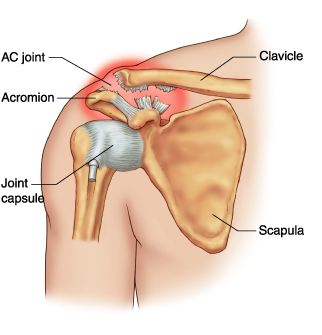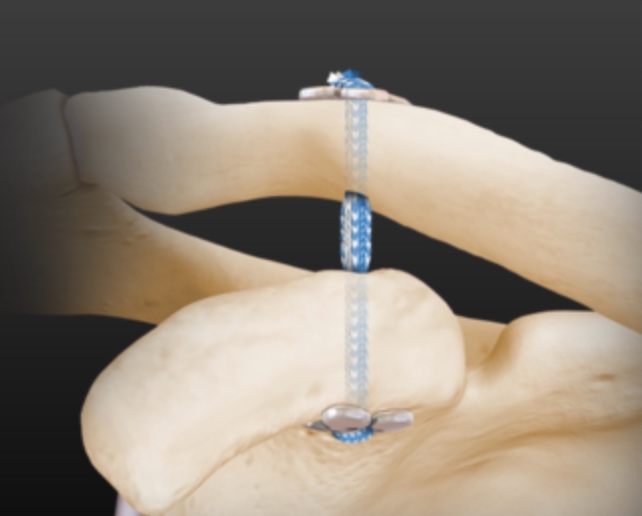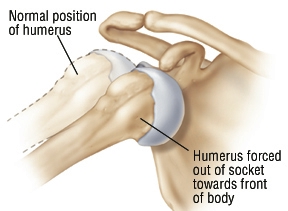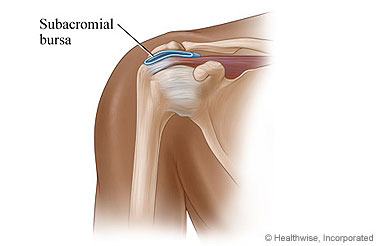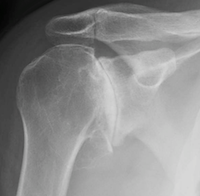Orthopaedics 360 INFO
An Acromioclavicular (AC) Joint disruption is fairly common, and usually occurs after a fall directly onto your shoulder. This happens commonly with a fall off a bicycle or a sporting injury where you are hit from the side. When the AC Joint is injured, there are certain types that require stabilisation. The injury is not a medical emergency, unless the clavicle is poking out through the skin or is associated with other major joint or bony fractures. An AC Joint can be treated any time, and in many cases, should be stabilised.
The image on the left shows an ACJ dislocation. There are many types of ACJ dislocations, and usually it will result in:
- Deformity over the shoulder tip
- Pain with overhead activities
- Inability to lift heavy weights
- Inability to throw
Once an ACJ injury is suspected, an Xray is performed to confirm the diagnosis and decide whether a stabilisation is necessary. Clavicles where all the ligaments have been ruptured often require surgery.
When an ACJ is only mild (i.e. grade 1 or 2), then non operative management is usually successful. A grade 1 or 2 ACJ dislocation means that some of the ligaments are intact in the shoulder. This results in a very stable joint, despite the fact that some of the ligaments are strained or even ruptured. If a minor strain is found, the following should be attempted
- Short duration anti-inflammatory to reduce swelling and pain (Often started a few days after the injury)
- Continuing to move the shoulder with pendular movements (Pretend your arm is an elephant trunk and rotate your arm whilst leaning over)
- Rest and Ice to your shoulder
- Physiotherapy to maintain shoulder movements and improve range and strength.
Operative Treatment
When the ACJ is unstable, and operative management is required, there are multiple options. There is a plate, called a hook plate, which is highly stable, but needs to be removed once the ligament heals, and there are internal scaffolds. Dr Chien-Wen Liew utilised an internal scaffold using a minimally invasive method, to minimise soft tissue damage and allow the new ligament (made of scar tissue) to reform. A small incision on the top of the shoulder is made and the clavicle can be set to the correct tension. This is very important as some methods can over reduce the bone and place it into the wrong place. This can cause continued pain.
The Arthrex “Dog Bone” technique is used because it utilises a small metal anchor that looks like a dog bone. It is a highly secured way to holding the new scaffolding in place, and allows the exact tension to be applied.
Shoulder Dislocation
Orthopaedics 360 INFO "A Place to Learn" A shoulder dislocation can occur with sporting activities, or an accident where the arm is forced into an awkward position. The most common type of dislocation is called an "anterior" dislocation, where the ball (humeral head)...
Subacromial Bursitis
Orthopaedics 360 INFO "A Place to Learn" Shoulder bursitis is a common issue, causing difficulties with overhead movements and pain. It can come out of the blue, or due to irritation from repetitive movements. When it is suspected, there are a number of things that...
Shoulder Arthritis
Shoulder arthritis limits range of motion and function. LEARN MORE
Orthopaedics 360
Orthopaedics 360
P: (08) 7099 0188
F: (08) 7099 0171
Southern Specialist Centre
Orthopaedics 360
P: (08) 7099 0188
F: (08) 7099 0171
Health @ Hindmarsh
Orthopaedics 360
P: (08) 7099 0188
F: (08) 7099 0171

